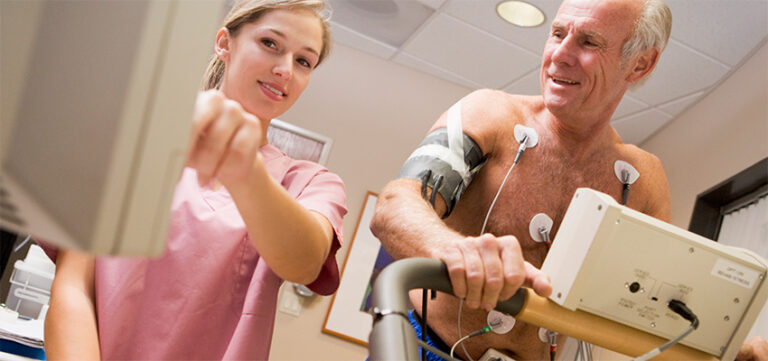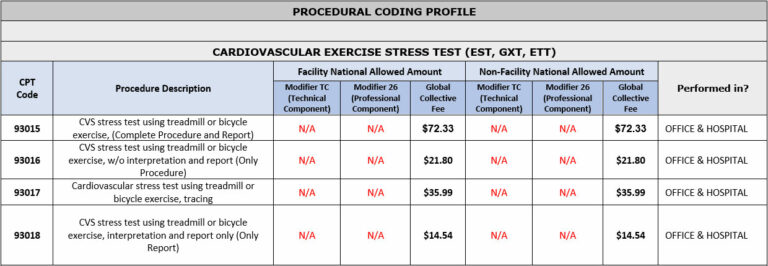
Five tips to improve coding for Cardiovascular Stress Testing
About eight million nuclear stress tests are performed annually in the United States. In recent years, the number of modalities for the evaluation of coronary artery disease (CAD) has increased significantly. Given these numbers the simple cardiology coding can be mind boggling in some instances, here we try to simplify it further for our readers.
What is Cardiovascular Stress Test about?
Stress tests are helpful diagnostic tools for various heart conditions. Cardiologists get an idea of how much strain a person’s heart can handle under strenuous circumstances. Which in-turns give a picture of how healthy their cardiac functions are.
How it is performed?
Artificial stress is stimulated on the patient’s heart to get the heart pumping. Usually, an exercise bike or treadmill is used, alternatively a pharmacological agent can also be used with patients who cannot manage to run or walk on treadmills.
Who performs it?
Common types include exercise stress test and the nuclear stress tests which are safely performed in a cardiologist’s office (Lab), supervised by a trained healthcare personnel. The physician continuously records the heart’s electrical activity (via electrodes) acquired by an assistant supervised by a qualified health care professional. It aids in monitoring the stress on the heart.
What are effective strategies for CAD Stress Tests?
In this article we go through some guidelines and strategies for coders who are interested in improving coding for cardiac stress tests.
Let’s begin with basic codes for Cardiac Stress Testing:
Stress Test CPT code 93015 is considered as the ‘global’ or comprehensive code that includes all the supervision, interpretation, and test. In contrast, Stress Test CPT code(s) 93016, 93017, and 93018 include management of the test, performing of test only, and understanding of priorly performed test, respectively.
Tip number 1: Review the component codes
While reviewing medical notes, it is obligatory to never miss which component needs to be billed. Stress codes don’t need any modifier to differentiate the billing of Technical or Professional components of the procedure performed. Instead, they already have four different designated codes. For instance, if the cardiologist in the office only reviewed the reports, then 93018 should be billed.
Tip number 2: Understand the facility and non-facility billing
Although for cardiovascular stress testing, the global code is allowed to be billed in Facility and Non-facility settings. Even with this allowance sometimes you have to split the codes into their component codes before billing (93016 and 93018 or both perhaps). This is usually significant for Facility settings. In offices or non-facility setting it is dependent on whether the Practice Provider owns the equipment or not. Billing the Global codes with POS 11 is fine if the testing is also performed there.
Tip number 3: Be well-aware what other Procedures were performed
CVS stress testing can be billed as TEE ECHO testing or Nuclear SPECT imaging. If TTE ECHO is performed, then we have to change the coding accordingly. 93351 is the global code used for TTE ECHO usually reserved to be billed in a non-facility setting only. If you want to bill the contrast separately then 93350 and add-on code +93352 should be billed, this coding tactic is usually followed in a facility setting. You have both of these billing options to choose from.
PROCEDURAL CODING PROFILE
*National Payment amounts have been used in this table, not specific to any MAC or Locality.
Tip number 4: Distinguish between billing Stress tests and TTE ECHO
You can bill CVS stress test codes 93016 and 93018 with 93350, when performed. Append appropriate modifiers where needed. However, you can cannot report 93350 with the 93015 global stress test code. Also, 93351 (TTE global code) cannot be billed with 93350 or other cardiovascular stress codes i.e., 93015-93018 codes, as per CPT coding guidelines.
Tip number 5: Don’t forget to bill add-on codes, if applicable
In case of doppler and color flow studies, you may bill them separately in addition to the parent stress test codes. Again, while billing any of the add-ons, make you sure the medical documentation is evident. After reviewing the medical charts bill them with appropriate component modifiers to distinguish which part of the service was actually performed.
AltuMED is a Healthcare Revenue Cycle Management technology and solutions company. Our technologically advanced Practice Management Software, PracticeFit optimizes the Medical Billing workflows for Medical Practices, Labs and Third-Party Medical Billing Companies helping them collect maximum revenue. Find out more.
Subscribe to Our Newsletter!
Subscribe to Our Newsletter!
Enter Your Email Address. We Promise We Won't Spam You



